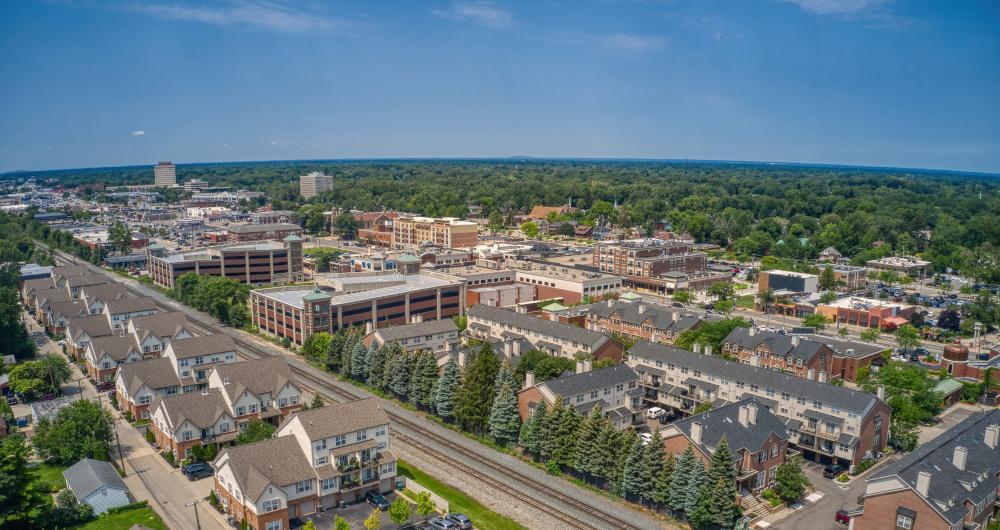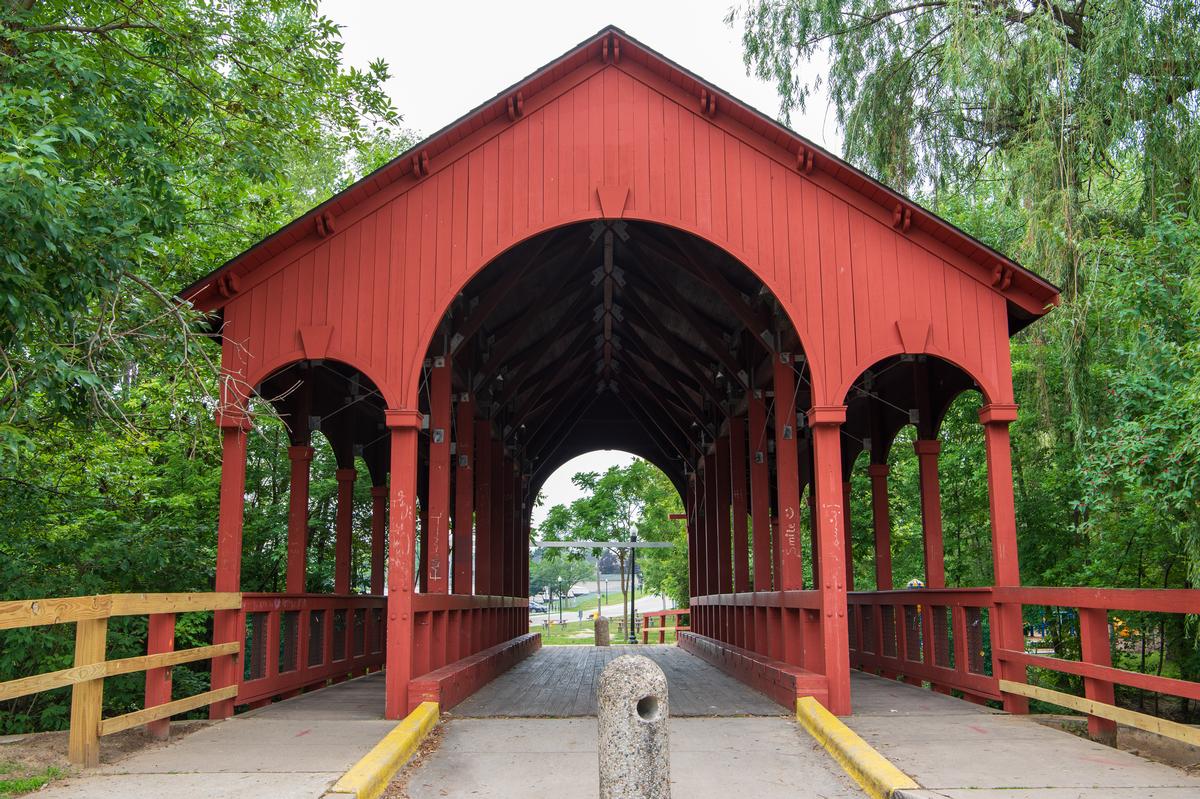Best Places to Visit in Michigan

Searching for the best places to travel in Michigan? Well, you are in the right place! The Great Lakes State is full of natural wonders and the coolest getaways! I’ve discovered breathtaking beaches, historic treasures, and hidden gems far from the usual tourist stops. I'm sharing my absolute favorites that I hope you'll enjoy too.

1. Mackinac Island - 4 hours and 30 minutes from Detroit
This is one of my favorite places to visit in Michigan. Why? First off, the island feels like stepping into another era. I loved that there are no cars, just bicycles and horse-drawn carriages. In addition, it’s easy to reach by ferry. Fall was especially beautiful here with crisp island air, warm afternoons, and peaceful evenings.
We found Mackinac Island nestled in Lake Huron between Michigan’s Upper and Lower Peninsulas and stayed four amazing days at Bicycle Street Inn and Suites for its prime location right on Main Street.
To get to Mackinac Island, I suggest taking a ferry from Mackinaw City or St. Ignace, since the ride only takes about 15–20 minutes and offers beautiful views of Lake Huron and the Mackinac Bridge. Ferry prices vary by company and season, but tickets are generally affordable and easy to book. This isn’t your only option, though—some hotels offer ferry packages, and you can also arrive by private boat. I prefer the ferry because it’s fast, scenic, and hassle-free.
If you make the trip to Mackinac Island, I think you should consider walking or biking along the 8.2-mile perimeter loop, exploring Arch Rock, and wandering through downtown. The island is famous for its fudge shops, historic buildings, and lake views, and there are countless places to stop for lunch, ice cream, or a quick coffee. You can also visit Fort Mackinac, stroll along the shoreline, hike wooded trails in Mackinac Island State Park, or simply relax and take in the slower pace of island life.
I’ll warn you that Mackinac Island can get very busy, especially in the summer, and it’s easy to spend a lot of time wandering without seeing the highlights. On our first visit, we opted for a guided experience to get oriented and make the most of our time. We thought that the historic carriage tour was a great introduction to the island.
What I loved best:
Watching a sunset from British Landing was my personal highlight.


2. Holland - 3 hour from Detroit
We absolutely love Holland, and have been many times. Resting along the edge of Lake Macatawa and just minutes from wide, sandy beaches, this is one of the most peaceful and scenic towns I’ve visited in the Midwest and I think it’s one of the best places for a relaxing Great Lakes escape. Why? First off, Holland offers miles of lakefront trails, and quiet dunes. In addition, it has a laid-back vibe far removed from the bustle of larger beach towns, so I find it perfect when I'm craving calm and natural beauty.
Famous for its Dutch roots, "Tulip City" feels both proudly historic and warmly modern, tulip-lined streets, charming windmills, and a vibrant downtown that hums with energy year-round.
Holland carries its traditions proudly, from wooden shoe carving to the annual Tulip Time Festival.
We stayed at Courtyard by Marriott Holland Downtown for two days and loved it for its walkable location and comfortable, family-friendly atmosphere. My favorite meal was dinner at New Holland Brewing, where the wood-fired pizza ($16) paired perfectly with a flight of local craft beers. My son loved the soft pretzel with beer cheese ($10), and the lively vibe made it a memorable evening.
I enjoyed wandering through Windmill Island Gardens, strolling along downtown’s 8th Street, and relaxing on the sandy shore of Holland State Park Beach. My son's favorite was Nelis’ Dutch Village, a family-friendly park celebrating Dutch traditions.
What I loved best:
Walking along the Holland Harbor Boardwalk with sweeping lake views was my personal highlight.

3. Traverse City
This is one of my favorite places to visit in northern Michigan because the city blends small-city charm with stunning natural beauty. Perched on the shores of Grand Traverse Bay, it’s a place where vineyards meet sandy beaches, and farm-to-table dining pairs naturally with stunning northern Michigan scenery that completely won me over.
What struck me most was the variety packed into such a walkable, welcoming place. One moment you’re exploring boutique shops downtown, the next you’re sipping wine overlooking rolling hills, or watching the sun set over Lake Michigan.
We reached Traverse City in 4 hours from Detroit and stayed at Hotel Indigo Traverse City for four days, right in the Warehouse District, which gave us easy access to downtown and the bay. My favorite meal was at The Little Fleet, a lively food truck park. I had the fish tacos ($14), while my son loved the wood-fired margherita pizza ($13). The casual outdoor vibe made it a perfect summer evening stop.
What I loved best:
National Cherry Festival in early July was my personal highlight.

4. Lansing - 1 hour 20 minutes from Detroit
Set along gentle rivers and surrounded by tree-lined neighborhoods, this is one of the most charming capital cities I’ve explored in the USA. I think it’s one of the best low-key getaways in Michigan. Why? Lansing offers peaceful parks, river trails, and a relaxed vibe.
This city surprised me with its mix of state history, cultural spots, and relaxed riverfront charm. As Michigan’s capital, it carries the weight of government and heritage, but it balances that with a youthful energy thanks to nearby Michigan State University .
What stood out most was the variety within reach. You can tour the soaring dome of the Capitol building in the morning, then wander art galleries or river trails by afternoon.
We stayed at Graduate East Lansing for four days, just across from the university, which made it easy to explore both Lansing and East Lansing. My favorite meal was at Meat BBQ, a local favorite featured on TV. The brisket sandwich ($14) was smoky and tender, while my son devoured the mac & cheese ($10). The casual, lively vibe made it one of those meals you remember long after the trip.
What I loved best:
Strolling through Old Town Lansing, full of boutiques, galleries, and cafés, was my personal highlight.

5. Tecumseh
Ready for a cozy, small-town getaway? Check out Tecumseh, a real standout in Lenawee County.
This place struck me as one of those small towns where charm and creativity shine through at every turn. Nestled in southeast Michigan, it blends historic brick streets with a surprisingly vibrant arts and dining scene, making it feel both timeless and refreshingly modern.
What stood out most was how walkable and welcoming it felt. Downtown is filled with galleries, antique shops, and cafés, yet you’re never far from trails, lakes, and rolling farmland.
After a one-hour drive from Detroit, we stayed at Tecumseh Inn Motel for four days, a simple and affordable spot close to downtown. My favorite meal was at The Dog House, a laid-back eatery known for its gourmet hot dogs and craft beers. I tried the bacon-wrapped jalapeño dog ($11), while my son loved the chili cheese dog ($10). Sitting outside on the patio, it felt like a slice of small-town life at its best.
What I loved best:
Visiting the Art Trail Tecumseh, an outdoor sculpture walk around town, was a standout.

6. Detroit
This is the largest city in Michigan and one of my favorite places to visit. Why? First off, I love how much there is to see and do, from history, culture and even nature in the parks! Secondly, it's a surprisingly affordable destination because of so many different accommodations options.
One of my favorite stops was John K. King Books, Michigan's largest used & rare bookstore (I learned that hey have 1,000,000 books in stock!).
Next we had brunch at Dime Store—duck confit hash with a runny egg and herbed hollandaise, savory and sharp, the café warm with the scent of coffee and citrus. Later, we wandered through the Wasserman Projects Art Gallery, where light spilled across large-scale installations and the silence of the space made you lean in.
Dinner at Prime and Proper was a study in style—white tablecloths, sharp service, and a perfectly cooked filet that arrived with roasted garlic and sea salt. Afterward, we stopped by Grey Ghost for dessert—salted caramel panna cotta, creamy and cool, the room humming with low music and soft conversations.
What I loved best:
Strolling along the Riverwalk, with skyline views and parks along the water was my favorite highlight.

7. Sault Ste. Marie, Michigan
Ready for a getaway filled with nature, history, and pure Upper Peninsula atmosphere? Check out Sault Ste. Marie, a real standout any time of year.
This place felt like a gateway to both history and natural wonder. Perched on the U.S.-Canada border along the St. Marys River, it’s the oldest city in Michigan and home to the world-famous Soo Locks — where massive freighters pass through a system that’s as fascinating today as it was a century ago.
What struck me most was the sense of scale and story. Watching a thousand-foot ship glide through the locks is humbling, but so is wandering the town’s quiet streets lined with heritage buildings. Add in the raw beauty of Lake Superior just minutes away, and you get a destination that balances engineering marvels with serene northern wilderness.
We drove 5 hours from Detroit and stayed at The Ojibway Hotel for two days, right across from the Soo Locks viewing platform. My favorite meal was at Lockview Restaurant, a classic diner-style spot serving up Great Lakes whitefish. The broiled whitefish platter ($18) was fresh and filling, while my son loved the perch basket ($15). Eating with a view of passing freighters made it feel uniquely “Soo.”
What I loved best:
Walking the Water Street Historic Block, with its preserved 19th-century buildings was a standout!


8. St. Joseph, Michigan
I fell for this place that immediately felt like a Lake Michigan treasure, a classic beach town with Midwestern warmth. Nicknamed the “Riviera of the Midwest,” it’s a place where sandy shores, lighthouses, and a walkable downtown all come together to create a relaxed and inviting atmosphere.
What stood out most was how family-friendly and picturesque it is. You can spend the morning strolling boutique shops and cafés downtown, then walk a few blocks to splash in the lake or watch sailboats drift by. St. Joseph balances small-town charm with natural beauty, and the sunsets over Lake Michigan are unforgettable.
We drove from Detroit for 3 hours and stayed at The Boulevard Inn & Bistro for two days, perched above downtown with sweeping lake views. My favorite meal was at Silver Beach Pizza, set inside a restored train depot by the Amtrak tracks. The margherita pizza ($16) was a hit, and my son loved the pepperoni deep-dish slice ($12). Watching trains pass while sharing a meal made it one of those uniquely “St. Joe” moments.
What I loved best:
Walking out to the St. Joseph North Pier Lighthouse for postcard-worthy views was my personal highlight.


9. Ann Arbor
I loved visiting this charming college town when we lived nearby, often arriving after an easy, low-stress drive.
This struck me as a city where intellect and creativity flow together, creating an atmosphere that feels both energetic and inviting. Anchored by the University of Michigan, it’s a place where bookstores, art galleries, cafés, and leafy neighborhoods all blend seamlessly with a lively downtown scene.
What stood out most was the city’s mix of culture and coziness. One moment you’re exploring a world-class museum, the next you’re sipping coffee in a quiet corner shop or wandering along the Huron River. Ann Arbor feels like a big small town — cosmopolitan enough to surprise you, but still approachable and warm.
We drove 45 minutes from Detroit and stayed at Graduate Ann Arbor for two days, a boutique hotel filled with collegiate charm, right in the heart of downtown. My favorite meal was at Zingerman’s Deli, an Ann Arbor institution. The Reuben ($18.50) was every bit as good as its reputation promised, while my son loved the grilled cheese ($12). Sharing a meal there felt like being part of the city’s story.
What I loved best:
Walking along the Huron River at Gallup Park.


10. Charlevoix
Dreaming of lake breezes, flower-filled streets, and fairytale cottages? I say head to Charlevoix, Michigan! This is one of my favorite Lake Michigan towns to visit. I’ve been lucky enough to explore this charming town nestled between Lake Michigan and Lake Charlevoix while based at 4-star Hotel Earl of Charlevoix, and I think you’ll fall for it just like I did.
March was an incredible time to visit Charlevoix, Michigan — winter was loosening its grip, yet the air still carried that crisp northern chill, and the town glimmered under a soft layer of lingering snow. I’d learned that early spring here feels like a secret season — quiet streets, half-frozen lakes, and a calm beauty before the summer crowds return.
After flying into Traverse City and driving the scenic route along Lake Michigan, I settled into a vacation rental near Round Lake for seven days, where sailboats rested patiently in the harbor. Days were spent wandering through the storybook downtown, and admiring Earl Young’s Mushroom Houses.
What I loved best:
Walking along the Charlevoix South Pier Lighthouse was my personal highlight.


11. Saginaw
Ready for a peaceful, arts-meets-nature escape? Check out Saginaw, a real standout in mid-Michigan.
Spring was an incredible time to visit — the last traces of winter lingered along the riverbanks, but the city was beginning to wake up with the promise of spring. I’d learned that early March here brings a quiet kind of beauty — misty mornings, peaceful parks, and locals eager for sunshine after months of snow.
After arriving via MBS International Airport, I settled into a charming downtown Airbnb for two days near the Saginaw River, where the soft glow of streetlights reflected on the still water each evening. Days were spent exploring Ojibway Island Park and the Japanese Cultural Center and Tea House, where the gardens were just starting to show signs of life. I wandered through Old Town Saginaw, with its restored brick buildings, quirky boutiques, and cozy cafés perfect for warming up between strolls.
What I loved best:
Sunset walks along the river were my personal highlight.

12. Grand Rapids
This place makes for one of my favorite day trips in the state because it blends art, history, and a cool, youthful vibe. Every time I visit, I’m surprised by how much there is to explore in just a single day, and it always feels refreshing.
We drove west across Michigan, watching the landscape shift from flat farmland to rolling hills as we neared the city. After just over two hours from Detroit, we reached Grand Rapids.
We started at the Frederik Meijer Gardens & Sculpture Park, and I loved wandering among the massive outdoor sculptures, lush gardens, and even a tropical conservatory. It was unusual and joyful to see art and nature come together so seamlessly—it felt like a hidden gem in the Midwest.
Downtown Grand Rapids had a spectacular energy, with its craft breweries, street art, and local shops.
I also enjoyed visiting the Grand Rapids Art Museum, where contemporary works and rotating exhibits gave me plenty to think about.
Afterwards we stopped at The Pump House Frozen Yogurt Bar - Knapps Corner and in July it really hit the spot and let us cool off.
What I loved best:
Walking along the riverfront tied the day together with views of the city that were both lively and peaceful.

13. South Haven
Framed by wide sandy beaches, rolling dunes, and a picturesque harbor, this is one of the most inviting shoreline communities I’ve explored in southwest Michigan.
March was an incredible time to visit — the town still wore its winter hush, yet the light off Lake Michigan had that first hint of spring shimmer. I’d learned that this shoulder season is one of the best-kept secrets on the lakeshore — quiet beaches, cozy cafés, and sunsets that seem to belong only to you.
After driving in from Grand Rapids, I checked into a snug rental for two days just steps from the South Haven Lighthouse. Mornings began with brisk walks along the pier, the air cool and fresh, gulls calling overhead as waves lapped against the frozen sand. By afternoon, I’d warm up in the local shops and coffeehouses downtown — no crowds, just the easy friendliness of a small harbor town easing out of winter.
Evenings brought the kind of stillness you can only find by the lake — the sun melting into the horizon, the water turning to glass, and a comforting quiet that felt like renewal itself.
What I loved best:
This place in March was a perfect mix of solitude and beauty, a pause between seasons that invited you to breathe and slow down.

14. Kalamazoo
This is one of my favorite mid-Michigan cities to visit because Kalamazoo blends a lively college-town spirit with a relaxed, creative energy.
The city buzzed softly with college-town energy as winter’s chill began to fade and hints of green returned to the parks this month. I’d learned that this in-between season is one of the most authentic times to experience Kalamazoo — when locals emerge for patio coffees, brewery tours, and long walks downtown without the summer rush.
After arriving via Kalamazoo/Battle Creek International Airport, I checked into a rental near Bronson Park for two days, surrounded by historic architecture and budding trees. Days were filled with wanderings through the Kalamazoo Mall, one of the first outdoor pedestrian shopping streets in the country, and a visit to the Kalamazoo Valley Museum for a dose of history and creativity.
Evenings were calm and cozy — streetlights reflecting on damp pavement after a light rain, live music spilling from tucked-away bars, and the comforting hum of a city shaking off winter.
What I loved best:
Exploring the city’s famous craft beer scene was my personal highlight — Bell’s Eccentric Café was the perfect place to spend an afternoon sampling local brews in the courtyard under the soft spring sun.

15. Dearborn
Rooted in automotive heritage and surrounded by leafy parks, this is one of the most culturally fascinating towns I’ve explored in the region. I think it’s one of the best places for a history-meets-modern-culture getaway. Why? Dearborn offers world-class museums, diverse food, peaceful walking trails, and a relaxed vibe far removed from busy downtown Detroit—yet still close enough to feel connected.
After landing at Detroit Metropolitan Airport, I made my base near The Henry Ford Museum of American Innovation, spending my days exploring the exhibits that tell the story of America’s inventors and dreamers. Just across the way, the Automotive Hall of Fame was a true highlight — an inspiring tribute to the pioneers who shaped the world on wheels.
What I loved best:
Walking among vintage cars, portraits, and stories of visionaries like Henry Ford and Soichiro Honda gave me a real sense of how this city fueled global innovation.



16. Houghton
Set on the edge of the Keweenaw Peninsula and surrounded by dense forests, clear water, and old mining history, this is one of the most striking small cities I’ve explored in the Midwest, and I think it’s one of the best places for anyone who loves nature and a bit of adventure. Why? Houghton offers scenic overlooks, peaceful waterfront trails, and that laid-back, outdoorsy vibe far removed from crowded tourist destinations.
This place felt like a true northern escape — a place where history, lake views, and outdoor adventure all meet at the edge of Michigan’s Upper Peninsula. Set along the Portage Canal and framed by rolling hills, its the gatewy to the Keweenaw Peninsula and carries the heritage of the copper mining era while embracing its role as a college town.
What stood out most was the balance of energy and quiet. With Michigan Tech University at its heart, Houghton has a youthful vibe, but it’s also deeply tied to its natural surroundings — from hiking trails and waterfalls to snowy winters that transform the area into a wonderland. The downtown’s mix of historic buildings and modern shops made it feel both authentic and welcoming.
We stayed at Pier B Resort Hotel for two days, right on the water with great views of the lift bridge. My favorite meal was at The Library Restaurant & Brew Pub, a Houghton staple. I had the whitefish tacos ($16), while my son enjoyed the burger and fries ($13). The view of the canal from our table made it one of those meals that felt both relaxing and distinctly local.
What I loved best:
For me, Houghton is one of the best spots in Michigan. It's romantic, peaceful, and a favorite escape I can’t wait to return to!
Hiking along the Maasto Hiihto Trails and enjoy panoramic views was my personal highlight.


Booking Checklist
1. Book Your Flight - I use Expedia because I like their mobile app with my itinerary. They've helped me re-book flights on many occasions. Once you reach their Gold tier, support is especially good.
2. Book Your Hotel - I use Booking.com or Expedia, depending on my destination.
3. Book Your Rental Car - I use Expedia.
4. Book your tours on Viator or Get Your Guide.
5. If you are planning to visit more than three national parks in the next 12 months, buy the America the Beautiful Pass.
